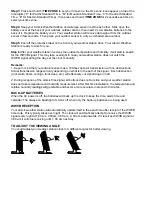
WWVB time and date will not
set or update
1.
Wait until overnight for signal to be received.
2.
Move your weather station away from sources of electricity.
3.
Place your weather station in window facing Colorado.
Time is one or few hours off
1.
Make sure you select the right U.S. time zone.
2.
Make sure you select DST Off if you live in an area where
Daylight Saving Time does not apply (part of Arizona and
Indiana)
CARE OF YOUR WEATHER STATION CLOCK
1.
Do not expose the unit to extreme temperature, water or direct sunlight.
2.
Avoid contact with any corrosive materials.
3.
Do not subject the unit to excessive force, dust or humidity.
4.
Do not open the inner back case or tamper with any components of this unit.
5.
Do not plug in any other AC/DC adaptor with incorrect specifications or voltage.
SPECIFICATIONS:
Temperature Range
Indoor
+32F to +113F (0C to +50C) (display shows HH.H / LL.L if out of this range)
Outdoor
-4F to +158F (-20C to +70C) (display shows HH.H / LL.L if out of this range)
Humidity Range
Indoor
20% - 95%
Outdoor
20% - 95%
Temperature Resolution
0.2F / 0.1C
RH% Resolution
1%
Air Pressure Range
850 hPa to 1050 hPa
25.1 inHg to 31.01 inHg
Alarm Duration
2 minutes
Snooze Duration
5 minutes
Temperature Resolution
0.2F / 0.1C
RH% Resolution
1%
Air Pressure Range
850 hPa to 1050 hPa
25.1 inHg to 31.01 inHg
Alarm Duration
2 minutes
Snooze Duration
5 minutes
FCC Statement
This device complies with Part 15 of the FCC Rules & RSS210. Operation is subject to the following
two conditions: (1) this device may not cause harmful interference, and (2) this device must accept any
interference received, including interference that may cause undesired operation.
FCCID: TIUIW001WT
NOTE: This equipment has been tested and found to comply with the limits for a Class B digital device,
pursuant to Part 15 of the FCC Rules. These limits are designed to provide reasonable protection
against harmful interference in a residential installation. This equipment generates, uses and can
radiate radio frequency energy and, if not installed and used in accordance with the instructions, may
cause harmful interference to radio communications. However, there is no guarantee that interference
will not occur in a particular installation. If this equipment does cause harmful interference to radio or
television reception, which can be determined by turning the equipment off and on, the user is

























